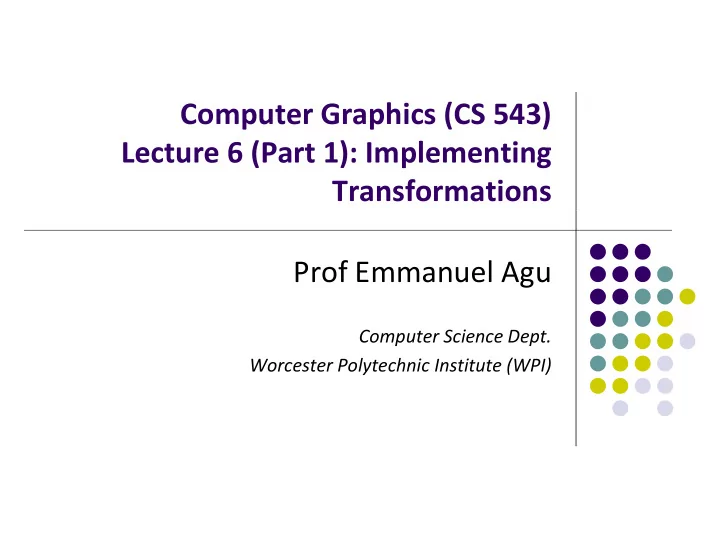

Computer Graphics (CS 543) L Lecture 6 (Part 1): Implementing 6 (P 1) I l i Transformations Prof Emmanuel Agu Prof Emmanuel Agu Computer Science Dept. p p Worcester Polytechnic Institute (WPI)
Arbitrary Matrices Can multiply by matrices from transformation commands (Translate, Rotate, Scale) into CTM ( , , ) Can also load arbitrary 4x4 matrices into CTM 1 1 0 0 1 15 3 3 0 2 0 12 Load into CTM Matrix CTM Matrix 34 34 0 0 3 3 12 12 0 24 0 1
Matrix Stacks Sometimes want to save transformation matrices for S ti t t t f ti t i f use later E.g: Traversing hierarchical data structures (Ch. 8) Pre 3.1 OpenGL maintained matrix stacks Right now just implement 1 ‐ level CTM Matrix stack later for hierarchical transforms Matrix stack later for hierarchical transforms
Reading Back State Can also access OpenGL variables (and other parts of the state) by query functions glGetIntegerv glGetFloatv glGetBooleanv glGetDoublev glIsEnabled lI E bl d Example: to find out maximum number of texture units glGetIntegerv(GL_MAX_TEXTURE_UNITS, &MaxTextureUnits);
Using Transformations Example: use idle function to rotate a cube and mouse function to change direction of rotation Start with program that draws cube as before Centered at origin Centered at origin Sides aligned with axes
main.c void main(int argc, char **argv) { glutInit(&argc, argv); glutInit(&argc, argv); glutInitDisplayMode(GLUT_DOUBLE | GLUT_RGB | GLUT_DEPTH); glutInitWindowSize(500 glutInitWindowSize(500, 500); 500); glutCreateWindow("colorcube"); glutReshapeFunc(myReshape); glutDisplayFunc(display); l tDi l F (di l ) Calls spinCube continuously glutIdleFunc(spinCube); Whenever OpenGL program is idle glutMouseFunc(mouse); glEnable(GL_DEPTH_TEST); glutMainLoop(); }
Idle and Mouse callbacks void spinCube() { theta[axis] += 2.0; if( theta[axis] > 360.0 ) theta[axis] -= 360.0; glutPostRedisplay(); } void mouse(int button, int state, int x, int y) { if(button==GLUT_LEFT_BUTTON && state == GLUT_DOWN) axis = 0; if(button==GLUT_MIDDLE_BUTTON && state == GLUT_DOWN) axis = 1; i 1 if(button==GLUT_RIGHT_BUTTON && state == GLUT_DOWN) axis = 2; }
Display callback void display() id di l () { glClear(GL_COLOR_BUFFER_BIT | GL_DEPTH_BUFFER_BIT); ctm ctm = RotateX(theta[0])*RotateY(theta[1]) RotateX(theta[0])*RotateY(theta[1]) *RotateZ(theta[2]); glUniformMatrix4fv(matrix_loc,1,GL_TRUE,ctm); glDrawArrays(GL_TRIANGLES, 0, N); glDrawArrays(GL TRIANGLES 0 N); glutSwapBuffers(); } • Alternatively, we can send rotation angle and axis to vertex shader, , • Let shader form CTM then do rotation • Inefficient to apply vertex transform data in application (CPU) and send data to GPU to render
U i Using the Model ‐ view Matrix th M d l i M t i In OpenGL the model ‐ view matrix used to I O GL th d l i t i d t Transform 3D models Position camera (using LookAt function) (next) The projection matrix used to define view volume p j and select a camera lens (later) Although these matrices no longer part of OpenGL, Although these matrices no longer part of OpenGL, good to create them in our applications (as CTM)
3D? Interfaces Major interactive graphics problem: how to use 2D devices (e.g. mouse) to control 3D objects Some alternatives Virtual trackball 3D input devices such as the spaceball Use areas of the screen Distance from center controls angle, position, scale depending on mouse button depressed
GLUI User Interface Library by Paul Rademacher Provides sophisticated controls and menus Not used in this class/optional Virtual trackball
References Angel and Shreiner, Chapter 3 Hill and Kelley appendix 4 Hill and Kelley, appendix 4
Recommend
More recommend